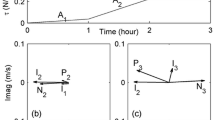Abstract
Shallow cold fronts with a north-west/south-east orientation sometimes experience blocking by the coastal mountain range of south-eastern Australia and greatly increase their propagation speed on the eastern (seaward) side of the range while they advance more slowly to the west of the range. The violent behaviour of some cold-frontal passages, or southerly busters, is found to be at least orographically initiated, but the phenomenon does not exhibit the characteristics of a coastally-trapped density current. The head of the front has the character of an evolving density current and its propagation is well predicted by density current theory over more than half of its lifetime. Nevertheless, it differs from steady laboratory-simulated examples in that a horizontal roll-vortex just behind the front is found to be accelerating relative to the rate of advection of cold air behind the front. This implies that its evolution will be governed by warm air entrainment, a fact which is confirmed by the observations. General agreement between extensive airborne observations over the ocean and measurements made at selected points along the coast indicates the usefulness of these basic studies for future improvement to forecasting in the near-coastal region.
Similar content being viewed by others
References
Baines, P. G.: 1980, ‘The Dynamics of the Southerly Buster’, Aust. Meteorol. Mag. 28, 175–200.
Bosart, L. F., Pagnotti, V., and Lettau, B.: 1973, ‘Climatological Aspects of Eastern United States Backdoor Frontal Passages’, Monthly Weather Rev. 101, 627–35.
Carr, J. A.: 1951, ‘The East Coast “Backdoor” Front of May 16th–20th, 1951’, Monthly Weather Rev. 79, 100–110.
Christie, D. R. and Muirhead, K. J.: 1979, ‘Intrusive Density Flows in the Lower Troposphere: A Source of Atmospheric Solitons’, J. Geophys. Res. 84, 4959–4969.
Clarke, R. H., Smith, R. K., and Reid, D. G.: 1981, ‘The Morning Glory of the Gulf of Carpentaria: An Atmospheric Undular Bore’, Monthly Weather Rev. 109, 1726–1750.
Colquhoun, J. R.: 1981, ‘The Origin, Evolution and Structure of Some Southerly Bursters’, Tech. Rep. No. 40, Australian Bureau of Meteorology, P.O. Box 1289K, Melbourne 3001, Australia.
Colquhoun, J. R., Shepherd, D. J., Coulman, C. E., Smith, R. K., and McInnes, K.: 1985, ‘The Southerly Burster of South Eastern Australia, an Orographically Forced Cold Front’, Monthly Weather Rev. (in prep.).
Coulman, C. E.: 1979, ‘Air-Sea Transfer Coefficients Determined from Measurements Made 200 km from Land’, J. Phys. Oceanogr. 9, 1053–1059.
Coulman, C. E. and van Dijk, M. H.: 1981, ‘Features of the Research Aircraft and an Intercomparison of Aircraft and Rawinsonde Data’, Tech. Rep. No. 46, Australian Bureau of Meteorology, P.O. Box 1289K, Melbourne 3001, Australia.
Gauntlett, D. J., Leslie, L. M., and Logan, L. E.: 1984, ‘Numerical Experiments in Mesoscale Prediction over Southeast Australia’, Monthly Weather Rev. 112.
Gentilli, J.: 1969, ‘Some Regional Aspects of Southerly Buster Phenomena’, Weather 24, 173–180.
Hunt, H. A.: 1894, ‘An Essay on Southerly Bursters’, J. Proc. R. Soc. NSW 28, 138–184.
Karman, T. von: 1940, ‘The Engineer Grapples with Nonlinear Problems’, Bull. Am. Math. Soc. 46, 616–683.
Kendrew, W. G.: 1951, The Climates of the Continents Fourth Edition. Clarendon Press, Oxford, 511–512.
Lilly, D. K.: 1981, ‘Doppler Radar Observations of Upslope Snowstorms’, Preprint, 20th Conf. on Radar Meteorol., held Boston Nov.–Dec., Meteorol. Soc.
Maxworthy, T.: 1980, ‘On the Formation of Nonlinear Interval Waves from the Gravitational Collapse of Mixed Regions in Two and Three Dimensions’, J. Fluid Mech. 96, 47–64.
Physick, W. L.: 1980, ‘Numerical Experiment on the Inland penetration of the Sea Breeze’, Quart. J. Roy. Meteorol. Soc. 106, 735–746.
Saunders, P. M.: 1967, ‘Aerial Measurement of Sea Surface Temperature in the Infrared’, J. Geophys. Res. 72, 4109–4117.
Saunders, P. M.: 1970, ‘Corrections for Airborne Radiation Thermometry’, J. Geophys. Res. 75, 7596–7601.
Simpson, J. E.: 1972, ‘Effects of the Lower Boundary on the Head of a Gravity Current’, J. Fluid. Mech. 53, 759–768.
Simpson, J. E., Mansfield, D. A., and Milford, J. R.: 1977, ‘Inland Penetration of Sea-Breeze Fronts’, Quart. J. Roy. Meteorol. Soc. 103, 47–76.
Smith, R. K. and Morton, B. R.: 1984, ‘atAn Observational Study of Northeasterly “Morning Glory” Wind Surges’, Aust. Meteorol. Mag. (in press).
Smith, R. K., Crook, N., and Roff, G.: 1982, ‘The Morning Glory: An Extraordinary Atmospheric Undular Bore’, Quart. J. Roy. Meteorol. Soc. 108, 937–956.
Wakimoto, R. M.: 1982, ‘The Life Cycle of Thunderstorm Gust Fronts as Viewed with Doppler Radar and Rawinsonde Data’, Monthly. Weather Rev. 110, 1060–1082.
Author information
Authors and Affiliations
Rights and permissions
About this article
Cite this article
Coulman, C.E., Colquhoun, J.R., Smith, R.K. et al. Orographically-forced cold fronts — Mean structure and motion. Boundary-Layer Meteorol 32, 57–83 (1985). https://doi.org/10.1007/BF00120714
Received:
Issue Date:
DOI: https://doi.org/10.1007/BF00120714




